|
MAIN PAGE
> Back to contents
Historical informatics
Reference:
Porshneva O.S., Razinkov S.L.
Database "Women diplomats in newly Independent States in the Former USSR (1991-2022)": structure and analysis possibilities
// Historical informatics.
2023. № 3.
P. 16-27.
DOI: 10.7256/2585-7797.2023.3.43766 EDN: XTSBNM URL: https://en.nbpublish.com/library_read_article.php?id=43766
Database "Women diplomats in newly Independent States in the Former USSR (1991-2022)": structure and analysis possibilities
Porshneva Ol'ga Sergeevna
ORCID: 0000-0002-3265-7010
Doctor of History
Professor, Head of the Chair of Theory and History of International Relations, Ural Federal University
620002, Russia, Sverdlovsk region, Yekaterinburg, Mira str., 19

|
o.s.porshneva@urfu.ru
|
|
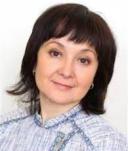 |
|
Razinkov Sergey Lvovich
ORCID: 0000-0002-0018-7931
PhD in History
Associate professor of the Chair of Theory and History of International Relations, Ural Federal University; Associate professor of the Chair of Document study, Law, History and Russian Language, Russian State Vocational Pedagogical University
620012, Russia, Sverdlovsk region, Yekaterinburg, Mashstroiteley str., 11, room 509

|
sergerazinkov@mail.ru
|
|
 |
Other publications by this author
|
|
|
DOI: 10.7256/2585-7797.2023.3.43766
EDN: XTSBNM
Received:
11-08-2023
Published:
12-10-2023
Abstract:
The article is devoted to the possibilities of a prosopographic database for studying the problems of gender representation of women in senior diplomatic positions. The authors characterize the structure of the database "Women diplomats in newly independent States in the former USSR (1991-2022)" and analyze the information contained therein. The analysis of the database data is aimed at identifying a number of significant characteristics of the social portrait of women diplomats of post-Soviet states (quantitative indicators in relation to various time periods and states, the ratio between career and non-professional diplomats, the distribution of ambassadors by host countries, the average age of appointment to the post of ambassador and other temporary indicators of professional career, the availability of professional education and the degree of proficiency in foreign languages). The problem-oriented approach to database design provided a flexible presentation of relevant information from sources diverse in structure and content and an effective analysis of the main characteristics of the social portrait of female diplomats (on the one hand, as a gender-homogeneous professional group, and on the other hand, as a nationally heterogeneous aggregate). Conclusions are formulated about the features of the social portrait of women diplomats of post-Soviet states based on the dynamics of the number, professional education, indicators of labor activity in senior diplomatic positions. The article identifies three groups of States with different models of gender representation in the diplomatic service.
Keywords:
diplomacy, female diplomats, post-Soviet states, prosopography, social portrait, collective biography, database, gender, facet classification, career diplomats
This article is automatically translated.
You can find original text of the article here.
Introduction
The profession of a diplomat has long been no longer the traditional prerogative of men, as evidenced, among other things, by the steady global trend towards an increase in the number of women holding senior diplomatic positions (from Ambassador Extraordinary and Plenipotentiary, heading an embassy or representation of a country in an international organization and up to the Minister of Foreign Affairs). Nevertheless, despite this trend, there is still a huge gender imbalance in the field of diplomatic activity - according to Swedish professors K. Aggestam and A. Tones in 2014, men occupied 85% of the posts of ambassadors in all countries of the world, and their share among key negotiators was even higher [5, p. 9-10].
Russian researchers define the situation with gender representation in the Russian Foreign Ministry as unfavorable for women, describing it with the metaphors of a "career maze" in addition to a "concrete wall" and a "glass ceiling" [2, p. 42] as an obvious gender imbalance and "vertical gender segregation", in which "on the way to the top of the administrative pyramids the number of women both in the Central Office and in foreign institutions tends to zero" [1, p. 25]. Researchers from other post-Soviet states also state the presence of gender imbalance in senior diplomatic positions at the national level [4, p. 4; 6, lp. 40].
To study the reasons for the persistence of gender imbalance in the diplomatic service in the newly independent states in the former USSR, a combination of qualitative and quantitative approaches is needed, including the use of prosopographic database technology, which is an effective tool for analyzing the social portrait and researching the collective biography of female diplomats.
The purpose of the database "Women Diplomats in Newly Independent States in the former USSR (1991-2022)" is to reconstruct the social portrait and collective biography of women who have held and are holding senior diplomatic positions in the foreign ministries of states in the post-Soviet space, on the one hand, as a gender homogeneous professional group, and, on the other hand, as heterogeneous social totality, the differences within which are due to the peculiarities of the formation of the diplomatic corps at the national-state level [3, p. 61]. The analysis of the database data is aimed at identifying a number of significant characteristics of the social portrait of women diplomats of post-Soviet states (quantitative indicators in relation to various time periods and states, the ratio between career and non-professional diplomats, the distribution of ambassadors by host countries, the average age of appointment to the post of ambassador and other temporary indicators of professional career, the availability of professional education and the degree of proficiency in foreign languages languages).
Sources of biographical information about diplomats are open and publicly available information resources: official websites of foreign ministries; legal acts, administrative documents and press releases on appointment and dismissal; summaries of diplomats posted on the web pages of embassies and international organizations; materials in the media, including interviews with diplomats; lists diplomatic corps; yearbooks published by foreign ministries; diplomats' pages on wikipedia and professional social networks, etc.
The multiplicity and diversity of the sources used, the weak structuring, the limitations and inconsistency of the information contained in them, as well as the specifics of the research tasks set led to the use of a problem-oriented approach in database design.
Characteristics of the database structure and tables
The prosopographic database is implemented in the Microsoft Access 2003 DBMS and has a structure (see Fig. 1), including the central table "Persons", the four main tables ("Training", "Career", "Academic degree", "Languages") associated with it by the one-to-many relationship, as well as four auxiliary reference tables ("SPR_STATES", "SPR_DOLZHNOSTI", "Jobs" and "Specialties") containing systematized information, respectively, about the countries of the world and international organizations, types of positions held in the diplomatic service, categories of jobs and specialties in education.
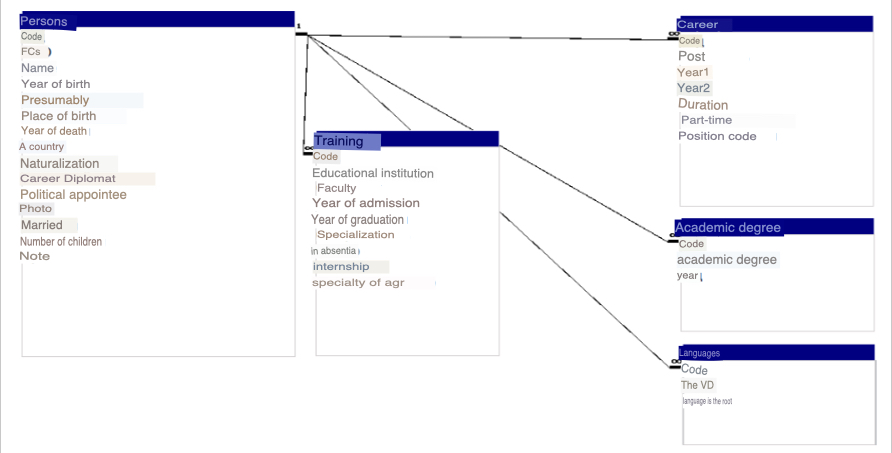
Fig. 1. Database data schema
The main table of the "Person", consisting of 15 fields, contains general socio-biographical information about female diplomats (the name of the person in Russian and the official language of the represented country, the year and place of birth, the state represented by the diplomat, signs of belonging to the category of career diplomats / political appointees, information about marital status, etc.) – total 255 entries as of 01.01.2023.
The nine fields of the "Training" table contain information about the professional education of diplomats, including postgraduate education, internships, retraining and advanced training courses (the name of the educational institution, faculty, period of study, received specialty and aggregated direction of training, etc.) – a total of 435 entries.
The seven fields of the Career table contain information about the professional activities of diplomats, both during their stay in the diplomatic service and in the previous/subsequent stage of their work (position, organization and structural unit, period of work, etc.) – a total of 1955 entries. At the same time, the duration of a person's stay in office is calculated programmatically based on data from the fields "Year1" (year of appointment to the position) and "Year2" (Year of dismissal (transfer) from the position).
In the "Career" table, the most important is the text field "Position Code", the data in which is formed on the basis of a facet-type classifier in the XXYYZZZ format, containing information about the type of position held (from the "Spr_dolzhnosti" table), the type of place of work (from the "Spr_Place of work" table) and its geographical localization (state or international organization from the table "Spr_states").
Facet X "Types of positions" encodes hierarchically ordered categories of positions held by a person during his/her working life both in the structure of the Department of Foreign Affairs and beyond (see Table 1). Hierarchy levels 1-3 include the highest diplomatic posts, the holders of which are the subject of this study. When assigning diplomatic posts to categories 4-6, the classification given in the work of L.N. Voevodina was used [2, p. 51]. Facet X reflects the sequence of a person's passage through all stages of a diplomatic career (starting from the lowest level), which is one of the metrics for assessing the degree of belonging of a particular person to the category of career diplomats (or, conversely, political appointees).
Table 1. Classifier "Types of positions"
|
Hierarchy level
|
Job categories
|
|
1
|
01 – Minister of Foreign Affairs
|
|
2
|
02 – Deputy Minister of Foreign Affairs
|
|
3
|
03 – Ambassador Extraordinary and Plenipotentiary
13 – head of a top-level linear structural unit in the Ministry of Foreign Affairs (management, department)
|
|
4
|
04 – senior diplomatic posts (Acting Ambassador; Consul General; Envoy Adviser, Charge d'affaires; senior adviser; adviser)
14 – head of a lower-level structural unit (department, sector)
|
|
5
|
05 – middle-level diplomatic ranks (1st Secretary; 2nd Secretary)
|
|
6
|
06 – lower diplomatic ranks (3rd secretary, attache, etc.)
|
|
7
|
09 – non-diplomatic work in the Ministry of Foreign Affairs
|
|
8
|
99 – other occupations (not related to foreign policy and diplomatic activities)
|
Facet Y "Type of place of work" contains generalized categories reflecting the localization of a person's workplace in the structure of institutions implementing the state's foreign policy. The classifier especially highlights categories 01 and 02, the values of which allow us to assess the proportionality of the ratio of a person's work time in the central office of the Ministry of Foreign Affairs and diplomatic representation abroad, which, in turn, is another metric for assessing the degree of belonging of a particular person to the category of career diplomats.
Table 2. Classifier "Type of place of work"
|
The category of the person's place of work
|
|
01 – central office of the Ministry of Foreign Affairs
|
|
02 – representation abroad
|
|
03 – work in the Ministry of Foreign Affairs (if it is impossible to identify more accurately)
|
|
04 – in parallel structures related to the formation of foreign policy (government, presidential administration, etc.)
|
Facet Z "Location" contains 287 entries (255 names of countries of the world and 32 names of international organizations), which allow geographically localizing the place of work of an employee in a diplomatic mission abroad.
An example of entering information into the "Persons" and "Career" tables using graphical forms is shown in Fig. 2-3.
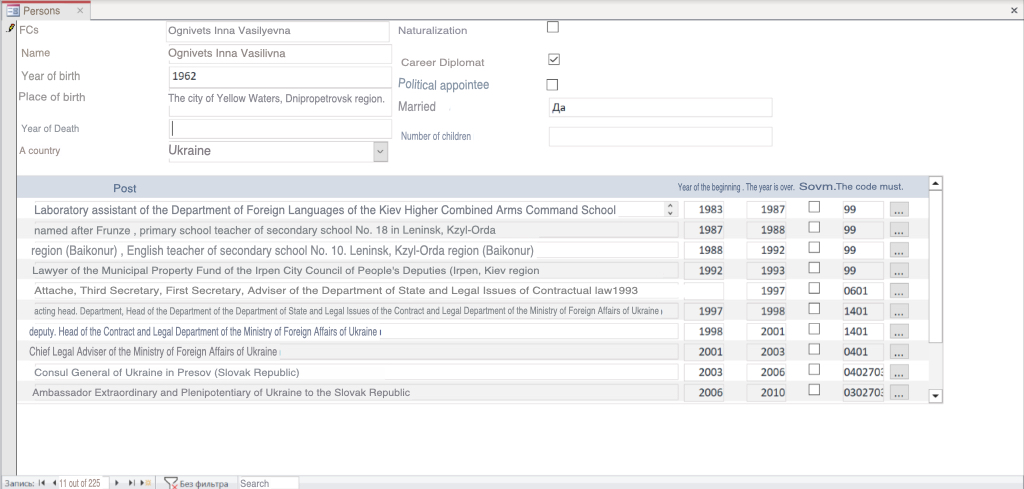
Fig. 2. Form with general information about the person and her work activity

Fig. 3. Example of a directory entry for the "Position code" field
The "Academic Degree" table contains information about whether a person has an academic degree and the time of its receipt (52 entries). The "Language" table combines data on foreign languages spoken by diplomats (language and proficiency level) – a total of 538 entries.
The tables "SPR_STATE", "SPR_ Duty", "SPR_PLACE of work" have a single structure and are auxiliary directories – closed lists of values that are used to simplify the input of encoded data into the fields of the main tables. The "Speciality Spr" table is also an auxiliary reference – an open list of values that are used to simplify data entry about the specialty received by a person.
The possibilities of the database for the study of the social portrait and collective biography of women diplomats
The database contains information about 225 women in senior diplomatic positions in the foreign ministries of the newly independent States in the territory of the former USSR. The initial results of the database data analysis are described in more detail in [4], below is only a brief description of individual indicators of the social portrait of women diplomats based on the database materials, including the states they represent (see Table 3).
Table 3. Characteristics of the social portrait of women diplomats of states in the post-Soviet space based on the database materials
The analysis of the database data on the change in the number of women diplomats in senior diplomatic positions in 1991-2021 in the context of specific post-Soviet states allowed us to identify three models of the number dynamics: 1) maintaining stable in time and insignificant in number indicators (Fig. 4); 2) the trend towards an increase in the number of female ambassadors since the 2000s (Fig. 5); 3) continuously high increase in population indicators (Fig. 6).
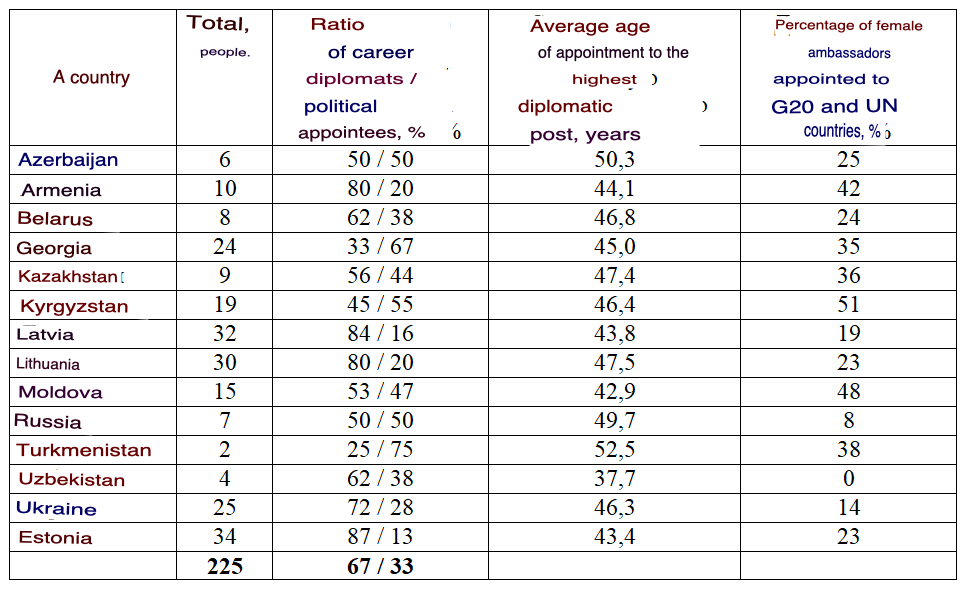
Fig. 4. Database data on the dynamics of the number of women ambassadors in Russia, Belarus and the post-Soviet states of Central Asia in 1991-2021.
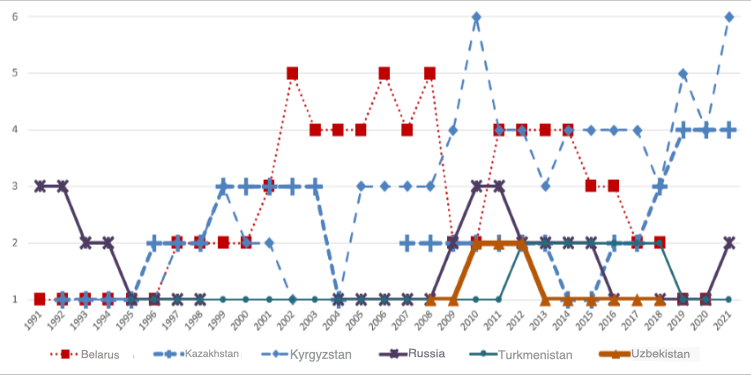
Fig. 5. Database data on the dynamics of the number of women ambassadors in Azerbaijan, Armenia and Georgia in 1991-2021.
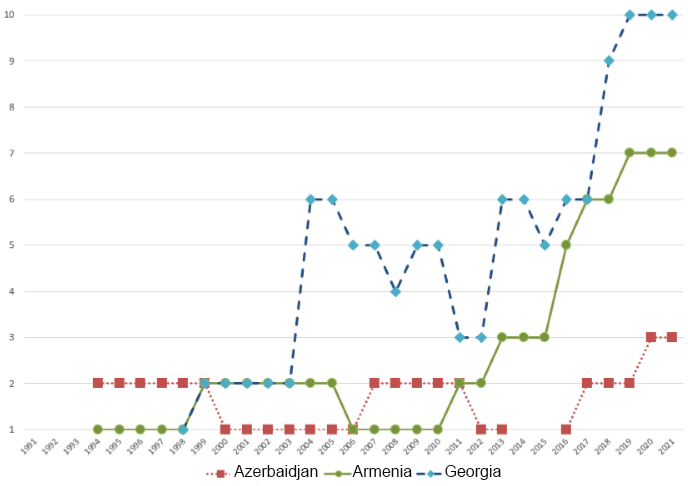
Fig. 6. Database data on the dynamics of the number of women ambassadors of Ukraine, Moldova and the Baltic States in 1991-2021.
Figure 7 shows the distribution of female diplomats by specialty by education, which at the level of specific States depends on the time period (the increase in the number of diplomats with a diploma in international relations over time) and the ratio between professional diplomats and political appointees.
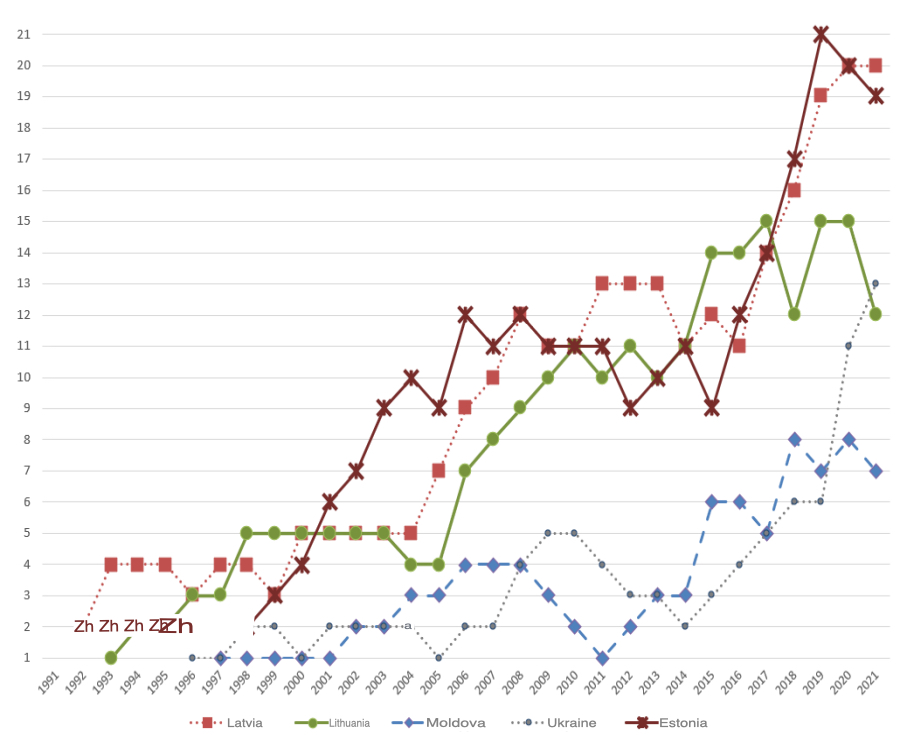

Figure 7. Distribution of female diplomats by professional education, in %
The results of the database data analysis (Fig. 8) confirm the general trend towards an increase in the proportion of career diplomats among women appointed heads of diplomatic missions [7, p. 22], while the ratio of career diplomats and political appointees differs significantly at the level of a particular state (Table 3).
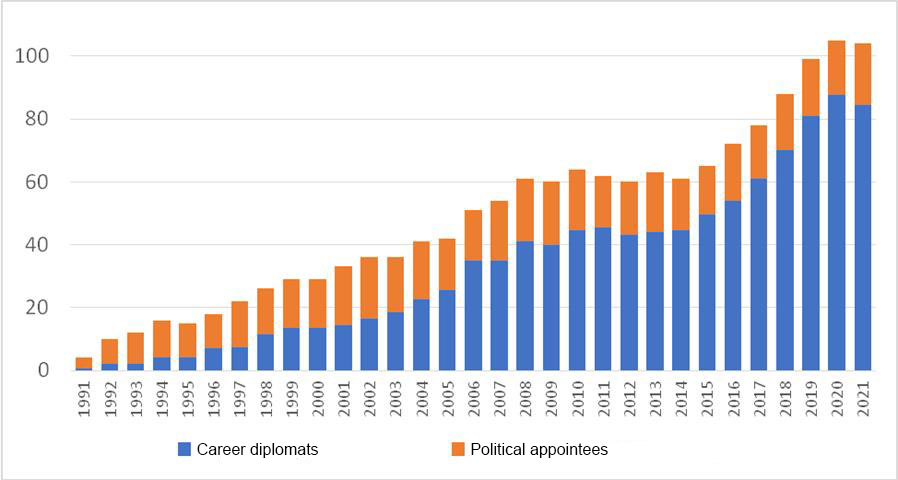
Fig. 8. Database data on the ratio of professional and non-professional diplomats among women in senior diplomatic positions in post-Soviet states, people.
The analysis of the database data on the geographical distribution of women ambassadors of post-Soviet states by countries of accreditation shows their wide representation (in 106 states and 19 international organizations), primarily in the countries of the European Union, the USA, Canada and China (Fig. 9), which, in many ways, contradicts the Western practice of appointing women ambassadors to small states of Africa and the Pacific, republics of the former USSR and Yugoslavia, but not in the strategically important G20 states [7, p. 13-18].
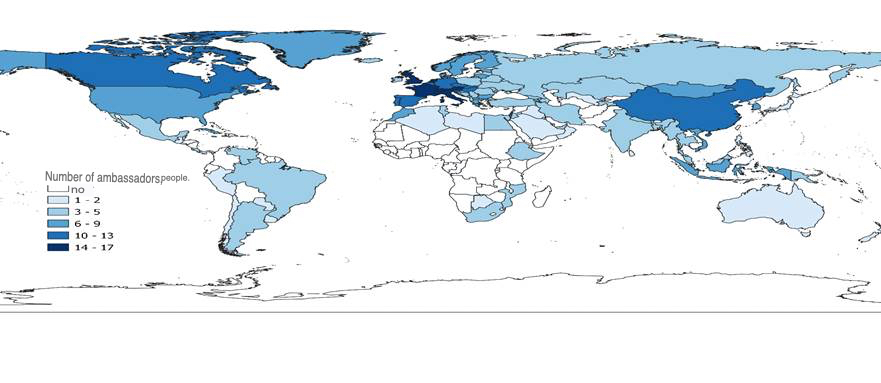
Fig. 9. Database data on the distribution of women ambassadors of post-Soviet states in the countries of the world in 1991-2021. (taking into account the combination of the position of ambassador in several countries)
Conclusion
The developed database is able to act as an effective means of reconstructing the social portrait and analyzing the collective biography of women who held or are holding senior diplomatic positions in the states of the former USSR in the period after independence.
The database structure, based on a problem-oriented approach to the study of the subject area, contains an optimal number of tables and fields that provide a flexible presentation of relevant information from sources diverse in structure and content and an effective analysis of the main characteristics of the social portrait of women diplomats (on the one hand, as a gender-homogeneous professional group, and on the other hand, as a nationally heterogeneous population). The analysis of the collective biography of women diplomats is reduced, first of all, to the study of temporary (duration) and structural (category of diplomatic position, territorial localization) characteristics of labor activity, the effectiveness of which is ensured by the use of reference tables and a facet-type job classifier containing information about the type of position held, institutional and geographical localization of a personal diplomatic career.
References
1. Voevoda, E. V., Morozov, V. M., & Karpov, V. V. (2018). Women diplomats in Russia: the case of gender disparity. Woman in Russian society, 4, 24–35. doi:10.21064/WinRS.2018.4.3
2. Voevodina, L. N. (2021). Gender imbalance in the Russian Federation diplomatic service: career labyrinth to the rank of ambassador extraordinary and plenipotentiary. In Science, society, innovations: topical issues and modern aspects (pp. 41-73). Penza: Nauka i prosveschenie.
3. Porshneva, O. S., & Razinkov S. L. (2023). Women in the highest diplomatic service positions in the states of the former USSR. The experience of creating a database. Bulletin of the Russian State Humanitarian University: series "Political Science, History, International Relations", 1, 57-75. doi:10.28995/2073-6339-2023-1-57-75
4. Zaharova, O., & Marcenyuk, T. (2015). Гендерні особливості дипломатичної служби в Україні та у світі [Gender features of the diplomatic service in Ukraine and in the world]. Kyiv: MCPD.
5. Aggestam, K., & Towns, A. (2019). The Gender Turn in Diplomacy: A New Research Agenda. International Feminist Journal of Politics, 21:1, 9–28.
6. Bleiere, D. (2020). Sievietes atjaunotās Latvijas ārējā un drošības politikā 1990. gados: ārlietu dienests [Women in the Foreign and Security Policy of a Renewed Latvia in the 1990s: Foreign Service]. In: A. Spruds & E. Vizgunova (Eds.), Women in Latvian Politics and Security Policy (pp. 27–60). Riga
7. Schiemichen, L. (2019). Madam Ambassador: A Statistical Comparison of Female Ambassadors across the U.S., German, and EU Foreign Services. EU Diplomacy Papers, 3. Retrieved from: http://aei.pitt.edu/102376
Peer Review
Peer reviewers' evaluations remain confidential and are not disclosed to the public. Only external reviews, authorized for publication by the article's author(s), are made public. Typically, these final reviews are conducted after the manuscript's revision. Adhering to our double-blind review policy, the reviewer's identity is kept confidential.
The list of publisher reviewers can be found here.
Gender equality is one of the cornerstones of modern society, which is reflected in the penetration of women into those professions that have long been considered traditionally male. By the way, the profession of a diplomat has also been considered "male" for a long time, although in Russian history one can name such a prominent diplomat as the Soviet ambassador to Sweden Alexandra Kollontai. It is all the more interesting to see a truly scientific study of the presence of women in the diplomatic corps of states in the post-Soviet space. These circumstances determine the relevance of the article submitted for review, the subject of which is women diplomats in the post-Soviet space. The author sets out to analyze a number of significant characteristics of the social portrait of women diplomats of post-Soviet states, as well as to determine the possibilities of the developed database for studying the social portrait and collective biography of women diplomats. The work is based on the principles of analysis and synthesis, reliability, objectivity, the methodological basis of the research is a systematic approach, which is based on the consideration of the object as an integral complex of interrelated elements. The paper also uses a problem-oriented approach. The scientific novelty of the article lies in the very formulation of the topic: the author seeks to characterize the developed database "Women diplomats in the newly independent states in the former USSR (1991-2022)" in order to study the causes of the persistence of gender imbalance in the diplomatic service in the newly independent states in the former USSR. Considering the bibliographic list of the article as a positive point, its versatility should be noted: as the author himself notes, "the sources of biographical information about diplomats are open and publicly available information resources: official websites of foreign ministries; legal acts, administrative documents and press releases on appointment and dismissal; summaries of diplomats posted on the web pages of embassies and international organizations; materials in the media, includinginterviews with diplomats; lists of the diplomatic corps; yearbooks published by foreign ministries; diplomats' pages on Wikipedia and professional social networks, etc." At the same time, we note as a serious drawback that this array of sources is completely not represented in the list of references. Among the studies attracted by the author, we note the works of L.N. Voevodina, O.S. Porshneva and other authors, whose focus is on the gender characteristics of the diplomatic service in the post-Soviet space. In general, in our opinion, the integrated use of various sources and research contributed to the solution of the tasks facing the author. The style of writing the article can be attributed to a scientific one, at the same time understandable not only to specialists, but also to a wide readership, to anyone interested in both gender studies in general and gender in diplomacy in particular. The appeal to the opponents is presented at the level of the collected information received by the author during the work on the topic of the article. The structure of the work is characterized by a certain logic and consistency, it can be distinguished by an introduction, the main part, and conclusion. At the beginning, the author determines the relevance of the topic, shows that the created database "contains information about 225 women in senior diplomatic positions in the foreign ministries of the newly independent states in the territory of the former USSR." The paper shows that "the results of the database data analysis confirm the general trend towards an increase in the proportion of career diplomats among women appointed heads of diplomatic missions, while the ratio of career diplomats and political appointees differs significantly at the level of a particular state." It is noteworthy that, contrary to Western experience, the analysis of database data on the geographical distribution of women ambassadors of post-Soviet states by accreditation countries "shows their wide representation (in 106 states and 19 international organizations), primarily in the countries of the European Union, the USA, Canada and China." The main conclusion of the article is that "the developed database is able to act as an effective means of reconstructing the social portrait and analyzing the collective biography of women who held or held senior diplomatic positions in the states of the former USSR in the period after independence." The article submitted for review is devoted to an urgent topic, is provided with 3 tables and 9 figures, will arouse readers' interest, and its materials can be used both in training courses and in the study of various gender aspects in the modern world. In general, in our opinion, the article can be recommended for publication in the journal "Historical Informatics".
Link to this article
You can simply select and copy link from below text field.
|
|




